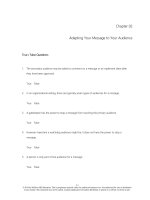Business communication building critical skill 6th module003
Bạn đang xem bản rút gọn của tài liệu. Xem và tải ngay bản đầy đủ của tài liệu tại đây (771.3 KB, 31 trang )
Communicating
across Cultures
Module Three
McGraw-Hill/Irwin
Copyright © 2014 by The McGraw-Hill Companies, Inc. All rights reserved.
Learning Objectives
LO 3-1 Define culture through context.
LO 3-2 Compare and contrast dimensions of culture.
LO 3-3 Apply strategies for international
communication success.
LO 3-4 Identify differences among generations.
LO 3-5 Apply strategies for workplace discrimination
solutions.
LO 3-6 Apply strategies for bias-free documents.
3-2
Diversity in the Workplace
3-3
Diversity in the Workplace
Valuing diversity is good business as well as
good social practice.
Ethnically diverse teams produce more and
higher-quality ideas.
3-4
What is “culture”?
High-Context Cultures
Most information is inferred from the context
of a message.
Little is “spelled out.”
Examples: Japanese, Arabic, and Latin American
cultures.
3-5
What is “culture”?
Low-Context Cultures
Context is less important than words.
Most information is explicitly spelled out
Examples: German, Scandinavian, and
dominant U.S. cultures.
3-6
Views of Communication in
High- and Low-Context Cultures
3-7
How does culture affect
business communication?
Culture influences
every single aspect of
business
communication:
how to show
politeness and respect
how much information
to give,
how to motivate
people
3-8
Dimensions of Culture
3-9
Cultural Contrasts in Motivation
3-10
How does culture affect
business communication?
Nonverbal communication
communication that doesn’t use words—takes
place all the time.
Body language, the size of an office, or how long
someone keeps a visitor waiting— all these
communicate pleasure or anger, friendliness or
distance, power and status
3-11
How does culture affect
business communication?
Posture and body movements connote energy
and openness
Open positions suggest that people are
accepting and open to new ideas.
Closed positions suggest that people are
physically or psychologically uncomfortable,
that they are defending themselves and
shutting other people out.
3-12
How does culture affect
business communication?
Personal space
the distance someone wants between himself
or herself and other people in ordinary, nonintimate interchanges
Touch, spatial arrangements
3-13
How does culture affect
business communication?
Monochronic cultures
treat time as a
resource
Polychronic cultures
emphasize
relationships
3-14
Oral Communication
Conversational style
denotes our conversational patterns and the
meaning we give to them: the way we show
interest, politeness, and appropriateness
3-15
Conversational Style
How long a pause tells you that it’s your
turn to speak?
Do you see interruption as rude?
Do you show interest by asking lots of
questions?
3-16
Cultural Contrasts in
Business Introductions
3-17
Cultural Contrasts in Written
Persuasive Documents
3-18
There are so many different cultures! How
can I know enough to communicate?
Being aware that values and behaviors are
influenced by culture.
Being flexible.
Being sensitive.
Being aware of the others’ values, beliefs, and
practices.
Being sensitive to differences among
individuals.
3-19
Are differences among generations changing the
workplace and how we communicate?
Millennials’ strengths include
Optimism
Confidence
Enthusiasm
Organization
Goal Orientation
Technology use
3-20
Are differences among generations changing the
workplace and how we communicate?
Read often to enhance literacy
Edit for grammar and proofread for spelling
Avoid e-mail abbreviations in business
correspondence
Use the appropriate tone, format, and language
Build common ground when negotiating
Find a mentor or role model
3-21
Dealing with Discrimination
Successfully handling discrimination means
understanding the situation and your
options:
Not everything is discrimination.
Decide on a strategy.
Chart your own path.
Take the high road.
3-22
How can I make my documents
bias-free?
Bias-free language
language that does not discriminate against
people on the basis of sex, physical condition,
race, age, or any other category.
Bias-free language is fair and friendly and
complies with the law.
3-23
Making Language Nonsexist
Nonsexist language treats both sexes
neutrally.
Check to be sure your writing is free from
sexism in four areas:
words and phrases, job titles, pronouns, and
courtesy titles.
3-24
Getting Rid of Sexist
Terms and Phrases
3-25









